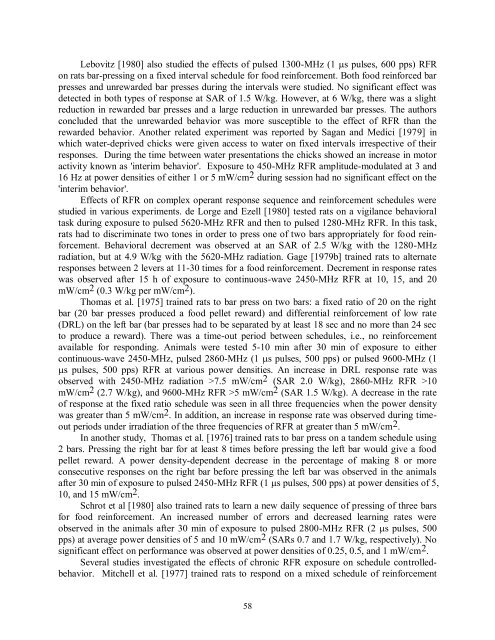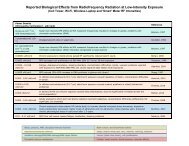Evidence for Effects on Neurology and Behavior - BioInitiative Report
Evidence for Effects on Neurology and Behavior - BioInitiative Report
Evidence for Effects on Neurology and Behavior - BioInitiative Report
Create successful ePaper yourself
Turn your PDF publications into a flip-book with our unique Google optimized e-Paper software.
Lebovitz [1980] also studied the effects of pulsed 1300-MHz (1 s pulses, 600 pps) RFR<br />
<strong>on</strong> rats bar-pressing <strong>on</strong> a fixed interval schedule <str<strong>on</strong>g>for</str<strong>on</strong>g> food rein<str<strong>on</strong>g>for</str<strong>on</strong>g>cement. Both food rein<str<strong>on</strong>g>for</str<strong>on</strong>g>ced bar<br />
presses <strong>and</strong> unrewarded bar presses during the intervals were studied. No significant effect was<br />
detected in both types of resp<strong>on</strong>se at SAR of 1.5 W/kg. However, at 6 W/kg, there was a slight<br />
reducti<strong>on</strong> in rewarded bar presses <strong>and</strong> a large reducti<strong>on</strong> in unrewarded bar presses. The authors<br />
c<strong>on</strong>cluded that the unrewarded behavior was more susceptible to the effect of RFR than the<br />
rewarded behavior. Another related experiment was reported by Sagan <strong>and</strong> Medici [1979] in<br />
which water-deprived chicks were given access to water <strong>on</strong> fixed intervals irrespective of their<br />
resp<strong>on</strong>ses. During the time between water presentati<strong>on</strong>s the chicks showed an increase in motor<br />
activity known as 'interim behavior'. Exposure to 450-MHz RFR amplitude-modulated at 3 <strong>and</strong><br />
16 Hz at power densities of either 1 or 5 mW/cm 2 during sessi<strong>on</strong> had no significant effect <strong>on</strong> the<br />
'interim behavior'.<br />
<str<strong>on</strong>g>Effects</str<strong>on</strong>g> of RFR <strong>on</strong> complex operant resp<strong>on</strong>se sequence <strong>and</strong> rein<str<strong>on</strong>g>for</str<strong>on</strong>g>cement schedules were<br />
studied in various experiments. de Lorge <strong>and</strong> Ezell [1980] tested rats <strong>on</strong> a vigilance behavioral<br />
task during exposure to pulsed 5620-MHz RFR <strong>and</strong> then to pulsed 1280-MHz RFR. In this task,<br />
rats had to discriminate two t<strong>on</strong>es in order to press <strong>on</strong>e of two bars appropriately <str<strong>on</strong>g>for</str<strong>on</strong>g> food rein<str<strong>on</strong>g>for</str<strong>on</strong>g>cement.<br />
<strong>Behavior</strong>al decrement was observed at an SAR of 2.5 W/kg with the 1280-MHz<br />
radiati<strong>on</strong>, but at 4.9 W/kg with the 5620-MHz radiati<strong>on</strong>. Gage [1979b] trained rats to alternate<br />
resp<strong>on</strong>ses between 2 levers at 11-30 times <str<strong>on</strong>g>for</str<strong>on</strong>g> a food rein<str<strong>on</strong>g>for</str<strong>on</strong>g>cement. Decrement in resp<strong>on</strong>se rates<br />
was observed after 15 h of exposure to c<strong>on</strong>tinuous-wave 2450-MHz RFR at 10, 15, <strong>and</strong> 20<br />
mW/cm 2 (0.3 W/kg per mW/cm 2 ).<br />
Thomas et al. [1975] trained rats to bar press <strong>on</strong> two bars: a fixed ratio of 20 <strong>on</strong> the right<br />
bar (20 bar presses produced a food pellet reward) <strong>and</strong> differential rein<str<strong>on</strong>g>for</str<strong>on</strong>g>cement of low rate<br />
(DRL) <strong>on</strong> the left bar (bar presses had to be separated by at least 18 sec <strong>and</strong> no more than 24 sec<br />
to produce a reward). There was a time-out period between schedules, i.e., no rein<str<strong>on</strong>g>for</str<strong>on</strong>g>cement<br />
available <str<strong>on</strong>g>for</str<strong>on</strong>g> resp<strong>on</strong>ding. Animals were tested 5-10 min after 30 min of exposure to either<br />
c<strong>on</strong>tinuous-wave 2450-MHz, pulsed 2860-MHz (1 s pulses, 500 pps) or pulsed 9600-MHz (1<br />
s pulses, 500 pps) RFR at various power densities. An increase in DRL resp<strong>on</strong>se rate was<br />
observed with 2450-MHz radiati<strong>on</strong> >7.5 mW/cm 2 (SAR 2.0 W/kg), 2860-MHz RFR >10<br />
mW/cm 2 (2.7 W/kg), <strong>and</strong> 9600-MHz RFR >5 mW/cm 2 (SAR 1.5 W/kg). A decrease in the rate<br />
of resp<strong>on</strong>se at the fixed ratio schedule was seen in all three frequencies when the power density<br />
was greater than 5 mW/cm 2 . In additi<strong>on</strong>, an increase in resp<strong>on</strong>se rate was observed during timeout<br />
periods under irradiati<strong>on</strong> of the three frequencies of RFR at greater than 5 mW/cm 2 .<br />
In another study, Thomas et al. [1976] trained rats to bar press <strong>on</strong> a t<strong>and</strong>em schedule using<br />
2 bars. Pressing the right bar <str<strong>on</strong>g>for</str<strong>on</strong>g> at least 8 times be<str<strong>on</strong>g>for</str<strong>on</strong>g>e pressing the left bar would give a food<br />
pellet reward. A power density-dependent decrease in the percentage of making 8 or more<br />
c<strong>on</strong>secutive resp<strong>on</strong>ses <strong>on</strong> the right bar be<str<strong>on</strong>g>for</str<strong>on</strong>g>e pressing the left bar was observed in the animals<br />
after 30 min of exposure to pulsed 2450-MHz RFR (1 s pulses, 500 pps) at power densities of 5,<br />
10, <strong>and</strong> 15 mW/cm 2 .<br />
Schrot et al [1980] also trained rats to learn a new daily sequence of pressing of three bars<br />
<str<strong>on</strong>g>for</str<strong>on</strong>g> food rein<str<strong>on</strong>g>for</str<strong>on</strong>g>cement. An increased number of errors <strong>and</strong> decreased learning rates were<br />
observed in the animals after 30 min of exposure to pulsed 2800-MHz RFR (2 s pulses, 500<br />
pps) at average power densities of 5 <strong>and</strong> 10 mW/cm 2 (SARs 0.7 <strong>and</strong> 1.7 W/kg, respectively). No<br />
significant effect <strong>on</strong> per<str<strong>on</strong>g>for</str<strong>on</strong>g>mance was observed at power densities of 0.25, 0.5, <strong>and</strong> 1 mW/cm 2 .<br />
Several studies investigated the effects of chr<strong>on</strong>ic RFR exposure <strong>on</strong> schedule c<strong>on</strong>trolledbehavior.<br />
Mitchell et al. [1977] trained rats to resp<strong>on</strong>d <strong>on</strong> a mixed schedule of rein<str<strong>on</strong>g>for</str<strong>on</strong>g>cement<br />
58



